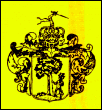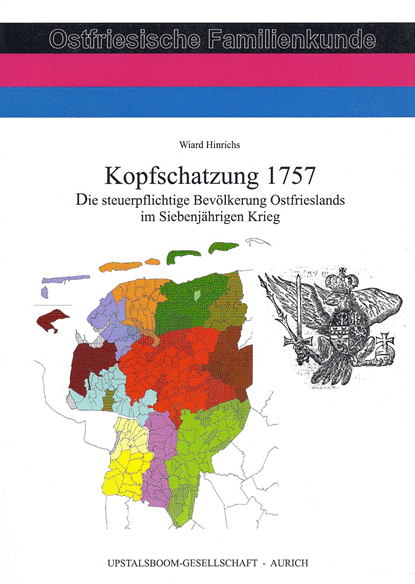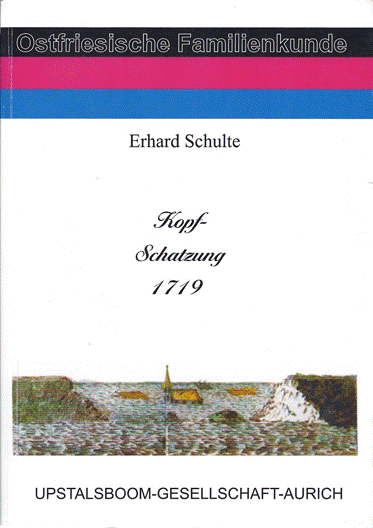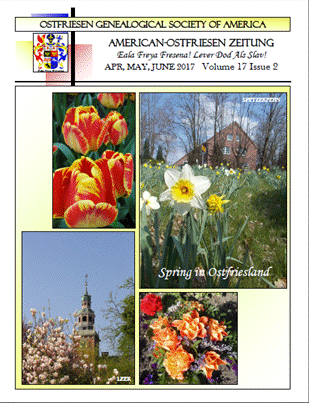If you've clicked on this site, you have ancestors who were most likely from the area of Germany known as Ostfriesland or East Friesland. This area is in northern Germany bordered by the North Sea and The Netherlands.
Make sure you document your ancestors' life in the USA. You must go from what is known about them to find out where to go. You cannot do research in Germany without the name of the village. Start with their death and marriage records for the place of birth. Another place that may list the place of birth is an obituary. While these are detailed in smaller towns in the United States, they are much more limited in larger cities. Obituaries in Germany have little information other than names of the survivors.
What records are available for Ostfriesen Research?
An increasing number of Ostfriesen research materials are being placed on-line or being published, however many of the resources are secondary sources rather than primary sources (the original records). Secondary sources may contain transcription or translation errors made by researchers. Primary records may also include errors but they were created soon after events occurred and people involved with the events generally contributed their knowledge to the records. Researchers should always attempt to verify the reliability of information they encounter and try to verify it against original records if possible. The internet has been a great resource for information sharing but fact checking what you find there is critical. Seeing something quoted a thousand times does not prove it is correct...
The OGSA has an extensive collection of primary and secondary sources in its collection which can be browsed on the Library holdings page. Other popular resources are listed below and in our Links pages database.
OGSA Emigration Database
OGSA has an emigration database containing information about 33,000+ Ostfriesen emigrants to the US. Access to this database is available to members who have helped support the development of the database. Users who have contributed to the database's support can access it through a link at the bottom of the
Member Section page after you log-in. If you would like to help support the database development and gain access, you can gain access by searching our Store for the "Special Collections",
Emigration Database.
The initial emigrant data was donated to us by Kurt von Loh of Borssum, Ostfriesland. Gene Janssen organized and entered the information into the current database and Gene continues to expand its contents through his research and submissions by our members. He has also made extensive efforts to reference records within OSBs whenever possible and OGSA has contributed emigration data to be used in the compilation of some of the recently published OSBs to help further connections between families on both sides of "the pond".
 |
 |
| Kurt von Loh |
Gene Janssen |
Original Church Records
Most villages are small and have only a single church that recorded the records of the community. Many records were microfilmed and are stored at either the regional archive in Aurich or at the Upstalsboom-Gesellschaft (the Ostfriesland genealogical society), which is located in the Ostfriesische Landschaft Bibliothek (library) in Aurich. If you wish to do original research on these records, you must call or write first to see what materials they have, what hours they are open, if you need an appointment - and if there is help available. All of their records are in German and translation help may or may not be available.
Ancestry.com has obtained the rights to provide many of the previously microfilmed records on-line using searchable indexes. The International version of their service is required to access these records. This can be added to a "standard" personal US access license or for free through many public libraries. Ancestry has many church records on-line that can be used to track emigrants and their families after arrival in the US.
Ortssippenbücher / Ortsfamielienbücher (OSB/OFB)

These are community lineage books written about a specific church in one village. A researcher compiles all the available data from the church, along with school data if available. While the data is compiled from original records, data in an OSB/OFB is considered a secondary source and should be verified if possible. A list of published
OSB/OFB is located here. While there are some privately published OFB, all of the OSB are published by the Upstalsboom-Gesellschaft in Aurich. These OSB are compiled by volunteers, many of whom spend years working on them.
Quellen und Forschungen
These are a publication of the Upstalsboom-Gesellschaft. Their issues started in the 1950’s and are still being published. These are written in newsletter style and are, of course, in German. Many of the issues contain genealogies of people who were willing to share their ancestry along with stories that can be translated. Many emigration lists are included as well as historical data, village data and other valuable information.
Ostfrieische Ahnenlisten
These are published genealogies of members of the Upstalsboom-Gesellschaft. There are many volumes of this valuable series that have been published. These are available through OGSA (in a private collection) and in Aurich. Many of the issues are also available at the Salt Lake City Family History Library. The information is considered a secondary source and should be verified. These issues contain valuable information and you must check them if you get a chance!
Ostfriesische Nachrichten Indexes

The Ostfriesische Nachrichten newspaper was published in Breda, Iowa for many years. Some libraries have microfilm copies of many issues of these newspapers which include birth and marriage announcements along with obituaries. All newspapers were printed in German.
Ancestry.com and FamilySearch.org
As noted above, some of the microfilmed Ostfriesen church records are available through Ancestry.com along with Fire Registration and other records. FamilySearch.org has other records available.
Tax Censuses


The 1719 Kopfschatzungregister is a type of census record taken after the disastrous 1717 Christmas Flood in order to ascertain who had money to help pay for the major improvements needed.
The 1757 Kopfschatzungregister is a similar type of census, but is more complete. It was taken twice in order to help pay for the Seven Years War. Both of these books are available in major libraries and several private collections.
OGSA Developed Resources

In addition to the Emigrant Database listed above, the OGSA has translated several publications from German to English to provide insights into the lives of our ancestors. We also have complied ten years of our journals in PDF format that is available on a memory stick. Check our Store for more information.

